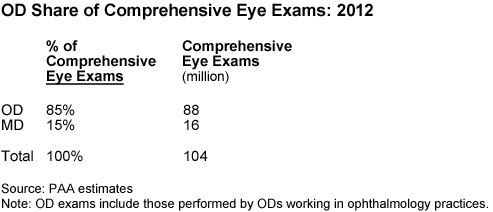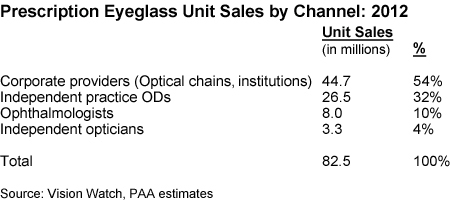By Thomas F. Steiner
Director of Market Research,
Review of Optometric Business Sponsored By Essilor and VisionWeb
AOA Excel recently commissioned Jobson Medical Information to assess the current status of the optometric profession and the future impact of major trends in the business, regulatory and technology environments. The AOA wanted an objective, third-party evaluation that weighed all available information on the eyecare industry from associations, publishers, manufacturers and government agencies.
>>The major findings of the report were presented at the AOA Optometry’s Meeting in June, 2013. The full report can be downloaded by clicking HERE<<
This article, the first of three, reports on optometry’s competitive position in the delivery of primary eyecare.
An overwhelming majority of Americans rely on optometrists for primary eyecare–a market defined here as including refractive eye exams and corrective devices. Primary eyecare is the principal source of OD revenue, typically accounting for 80 percent or more of collected billings among independent practice ODs.
There are no ongoing audits of the number of patients served or revenue produced by optometrists and ophthalmologists, but it’s possible to derive reasonable estimates of primary eyecare market share of the two professions by considering the number of professionals in practice and the numbers of patients the average practicing doctor sees each working day.
Based on these variables, for which reliable metrics are available or can be accurately estimated, ODs perform an estimated 88 million refractive eye exams annually of the total of 104 million performed by all eyecare professionals. Optometry’s market share of refractive exams is 85 percent. This includes eye exams performed by the more than 3,000 ODs who work in practices owned by ophthalmologists.
 OD Share of Comprehensive Eye Exams: 2012
OD Share of Comprehensive Eye Exams: 2012
ODs prescribe at least 90 percent of vision correction devices. Optometry’s commanding share of the primary eyecare market has slowly increased, as the number of practicing ODs has grown by 1.8 percent annually and the number of practicing ophthalmologists has been stable.
Despite optometry’s large annual output of primary eyecare, most ODs have not optimized the frequency of patient visits by achieving high patient compliance with a yearly eye exam regimen. It’s estimated that the 198 million people who use vision correction devices receive just 94 million exams annually, equivalent to one exam every 25 months. This occurs even as ODs encourage most patients to have yearly eye exams. If ODs were to reduce the average interval between eye exams from 25 months to 18 months, ODs would perform an additional 34 million eye exams annually, a 39 percent increase.
As optometry’s scope of practice has broadened, medical eyecare services have become a larger source of OD revenue. Medical eyecare services performed by ODs include monitoring of ocular complications from diabetes and treatment of ocular infection, dry eye, ocular allergies and glaucoma. Of the 97 million patient visits to offices owned by ODs in 2012, including both independent practice and corporate affiliated offices, nearly 18 million were for medical eyecare services. A majority of OD practices have not fully developed this revenue source.
Independent practice ODs dispense 26.5 million pairs of eyeglasses annually, representing 32 percent of total units sold. Commercial providers, primarily optical chains, command a 54 percent market share of eyewear units dispensed. In recent years, independent practice ODs’ share of US eyewear revenue has slowly increased.
 Prescription Eyeglass Unit Sales by Channel: 2012
Prescription Eyeglass Unit Sales by Channel: 2012
Because independent practice ODs perform 44 percent of the refractive exams, it’s apparent that a significant number of patients of independent practice ODs choose to buy eyewear from commercial providers. It’s estimated that independent practice ODs capture just 73 percent of the eyewear purchases of their patients. The walkout represents an annual loss of sales of 9.8 million pairs, with a retail value of $2.2 billion.
Optometry’s dominance of contact lens dispensing is greater than its dominance of eyewear dispensing. As with eye exams, medical eyecare and eyewear dispensing, ODs do not realize the full revenue potential of their contact lens wearer bases. Typically, 20 percent of contact lens purchases of patients of independent practice ODs are made with optical chain and internet sellers. ODs also achieve a relatively low level of patient compliance with lens replacement recommendations, resulting in sub-optimal annual consumption of lenses.
Actions to Increase Market Share
This overview of optometry’s output and competitive situation identifies several priorities for ODs to improve office processes to increase market share, including:
• Improve recall processes. Many ODs devote too few resources to patient recall, ceding control over the timing of exam visits to patients. Less than half of OD independent practices and fewer than 20 percent of corporate affiliated practices pre-appoint patients.
• Upgrade eyewear purchase experience. Independent practice ODs experience lower than desired capture rates of patient eyewear purchases, largely because they devote too little management attention to eyewear merchandising.
• Broaden scope of practice. Providing a broader range of services to patients is an effective patient retention strategy with major potential to expand revenue.
Thomas F. Steiner, Director of Market Research for ROB, has spent more than 25 years helping eyecare practices succeed, including pioneering the introduction of color contact lenses into optometry. To contact him: tom.steiner@cibavision.com

























